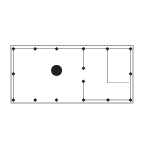Enter the unmistakable smell of the workplace. Three different colognes and two perfumes, one of them identifiable. The scent of warm copies and instant coffee. Torsos and legs move back and forth. Heads and shoulders are silhouettes on a white screen illuminated by afternoon sunlight through full height windows. Traces of work are all around but partially obscured. The person you’ve come to see is seven feet away, but you’ll walk fifty to reach their desk. The sound of a fax on your left is backed by the march of steady typing. Over the sound of your footsteps, you make out a sales call.
Copyright © 2018 Evio Isaac
Hang in there...
Project Info
Program: Tenant Improvement
Location: Houston, TX
Year: 2018
Abstract:
Typically a secondary, technical deliverable, the reflected ceiling plan is a drawing used by architects to communicate the position of fixtures, mechanical penetrations, lighting and finishes to the build team. Ceilings construed by the reflected ceiling plan as a secondary drawing systematically eliminate difference. My ambition is to investigate the possibility of the reflected ceiling plan as a primary drawing in order to challenge the absoluteness of the architectural plan. Following the rules of this architectural role-play, the suspended ceiling becomes autonomous instead of codependent. It becomes diaphanous and promiscuous; technical and representational and full of programmatic ambition. The RCP constructs an architecture of suspense.
Suspense describes two complementary conditions: the state or condition of physically hanging and the state or condition of mental uncertainty or excitement. An architecture of suspense interrupts the continuous space of the architectural plan. It produces indeterminacy through sensorial occlusion. It can’t be perceived in its totality and produces both flatness and thickness. Suspense produces deep, climatic ceilings and fuzzy, sensorial boundaries. It operates through connotation and difference. It renders service equipment with profiles, edges, and faces and it amplifies thermal and sensorial texture through intensity and proximity. It welcomes differentiation and specificity, and implies collectivity through shared sensation.
Adviser: Michelle Chang
